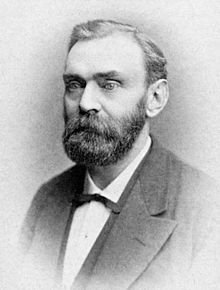|
Alfred Bernhard Nobel
From Wikipedia, the free
encyclopedia
Alfred Bernhard Nobel (/noʊˈbɛl/;
Swedish: [ˈalfrɛd noˈbɛl] listen (help·info);
21 October 1833 – 10 December 1896) was a
Swedish chemist, engineer, innovator, and
armaments manufacturer.
He was the inventor of dynamite. Nobel also
owned Bofors, which he had redirected from
its previous role as primarily an iron and
steel producer to a major manufacturer of
cannon and other armaments. Nobel held 350
different patents, dynamite being the most
famous. His fortune was used posthumously to
institute the Nobel Prizes. The synthetic
element nobelium was named after him. His
name also survives in modern-day companies
such as Dynamit Nobel and AkzoNobel, which
are descendants of mergers with companies
Nobel himself established.
Born in Stockholm, Alfred Nobel was the fourth son of Immanuel Nobel
(1801–1872), an inventor and engineer, and
Carolina Andriette (Ahlsell) Nobel
(1805–1889).[1] The couple married in 1827
and had eight children. The family was
impoverished, and only Alfred and his three
brothers survived past childhood.[1][2]
Through his father, Alfred Nobel was a
descendant of the Swedish scientist Olaus
Rudbeck (1630–1702),[3] and in his turn the
boy was interested in engineering,
particularly explosives, learning the basic
principles from his father at a young age.
Alfred Nobel's interest in technology was
inherited from his father, an alumnus of
Royal Institute of Technology in
Stockholm.[4]
Following various business failures, Nobel's
father moved to Saint Petersburg in 1837 and
grew successful there as a manufacturer of
machine tools and explosives. He invented
modern plywood and started work on the
"torpedo".[5] In 1842, the family joined him
in the city. Now prosperous, his parents
were able to send Nobel to private tutors
and the boy excelled in his studies,
particularly in chemistry and languages,
achieving fluency in English, French,
German, and Russian.[1] For 18 months, from
1841 to 1842, Nobel went to the only school
he ever attended as a child, the Jacobs
Apologistic School in Stockholm.[2]
As a young man, Nobel studied with chemist
Nikolai Zinin; then, in 1850, went to Paris
to further the work; and, at 18, he went to
the United States for four years to study
chemistry, collaborating for a short period
under inventor John Ericsson, who designed
the American Civil War ironclad USS Monitor.
Nobel filed his first patent, for a gas
meter, in 1857.[2][6][1]
The family factory produced armaments for
the Crimean War (1853–1856); but, had
difficulty switching back to regular
domestic production when the fighting ended
and they filed for bankruptcy.[1] In 1859,
Nobel's father left his factory in the care
of the second son, Ludvig Nobel (1831–1888),
who greatly improved the business. Nobel and
his parents returned to Sweden from Russia
and Nobel devoted himself to the study of
explosives, and especially to the safe
manufacture and use of nitroglycerine
(discovered in 1847 by Ascanio Sobrero, one
of his fellow students under Théophile-Jules
Pelouze at the University of Paris). Nobel
invented a detonator in 1863; and, in 1865,
he designed the blasting cap.[1]
On 3 September 1864, a shed, used for the
preparation of nitroglycerin, exploded at
the factory in Heleneborg Stockholm, killing
five people, including Nobel's younger
brother Emil.[2] Dogged by more minor
accidents but unfazed, Nobel went on to
build further factories, focusing on
improving the stability of the explosives he
was developing.[2] Nobel invented dynamite
in 1867, a substance easier and safer to
handle than the more unstable nitroglycerin.
Dynamite was patented in the US and the UK
and was used extensively in mining and the
building of transport networks
internationally.[1] In 1875 Nobel invented
gelignite, more stable and powerful than
dynamite, and in 1887 patented ballistite, a
forerunner of cordite.[1]
Nobel was elected a member of the Royal
Swedish Academy of Sciences in 1884, the
same institution that would later select
laureates for two of the Nobel prizes, and
he received an honorary doctorate from
Uppsala University in 1893.
Alfred Nobel's death mask, at Bjorkborn,
Nobel's residence in Karlskoga,
Sweden.Nobel's brothers Ludvig and Robert
exploited oilfields along the Caspian Sea
and became hugely rich in their own right.
Nobel invested in these and amassed great
wealth through the development of these new
oil regions. During his life Nobel issued
350 patents internationally and by his death
had established 90 armaments factories,
despite his belief in pacifism.[1]
In 1888, the death of his brother Ludvig
caused several newspapers to publish
obituaries of Alfred in error. A French
obituary stated "Le marchand de la mort est
mort" ("The merchant of death is dead").[1]
In 1891, following the death of his mother
and his brother Ludvig and the end of a
longstanding relationship, Nobel moved from
Paris to San Remo, Italy. Suffering from
angina, Nobel died at home, of a cerebral
hemorrhage in 1896. Unbeknownst to his
family, friends or colleagues, he had left
most of his wealth in trust, in order to
fund the awards that would become known as
the Nobel Prizes.[1] He is buried in Norra
begravningsplatsen in Stockholm.
|

